
Since 2017, Exponential Center interns have helped to advance initiatives at CHM. Their research and content development has helped lay the foundation for the events, education materials, oral histories, and more. Each class of interns brings new talents and knowledge bases to their work, building on the contributions of their predecessors. Their projects explored new audiences and new mediums for the center and CHM. This year was no exception.
In June 2019, four college students from universities on opposite coasts and studying fields as diverse as global studies and computer science arrived at CHM. They had worked in a museum, a startup, a security and privacy lab, and a rowing club. They knew languages ranging from French to Spanish to Korean to Python. They all shared a passion for entrepreneurship and innovation.
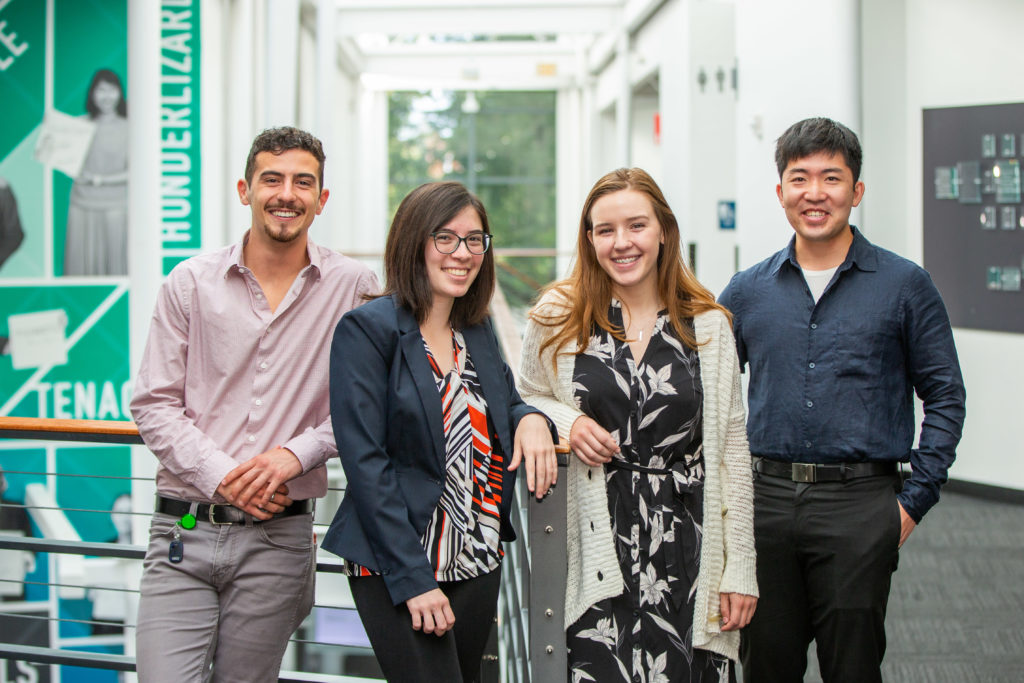
Left to right: Felipe Silveira, a global studies major at UC Santa Barbara; Nicole Gates, a computer science major at Wellesley College; Allison Ransom, a global liberal studies major at New York University; Sungmin Park, a recent cognitive science graduate from UC Davis.
Here are some highlights of their work this year.
On their first day, the interns hit the ground running, working to prepare an activity for CHM’s Teen Takeover, an annual after-hours event where teens explore how technology helps define the past, present, and future of society. Exponential would add an entrepreneurial spin by developing activities for teens that distilled lessons from its One Word initiative. The goal: to empower teens to see themselves as future entrepreneurs.
In addition to creating two “mythbusters” posters, interns created three activities to spark teens’ interest in entrepreneurship: a “wordle” or word cloud that updated in real time; a timed business pitch challenge; and a “One Word” word scramble game. The activities were designed to be fun and interactive, garnering roughly 300 instances of engagement, to make entrepreneurial topics accessible to the event’s nearly 500 attendees.
The experience was a rewarding one for participants and for the interns, whose roles as facilitators required a quick transformation from CHM novices into entrepreneurial experts. Planning and facilitating these activities, all during their first week, fostered confidence and a strong team dynamic that would carry through their projects for the rest of the summer. Most importantly, the event became one of their favorite summer memories.
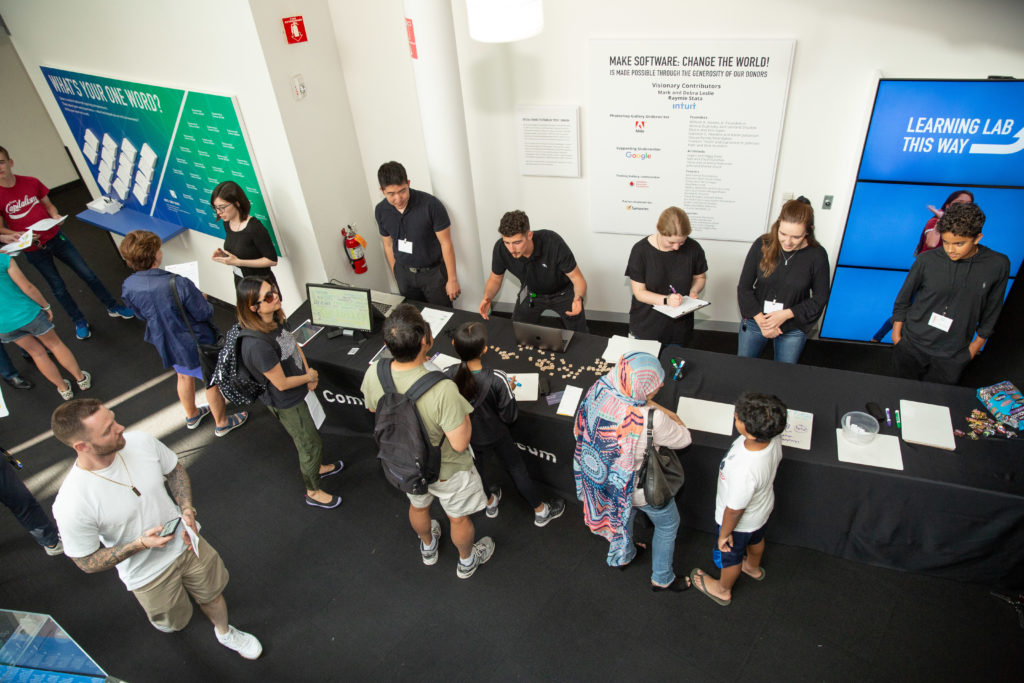
The intern team facilitates three One -Word–based activities.
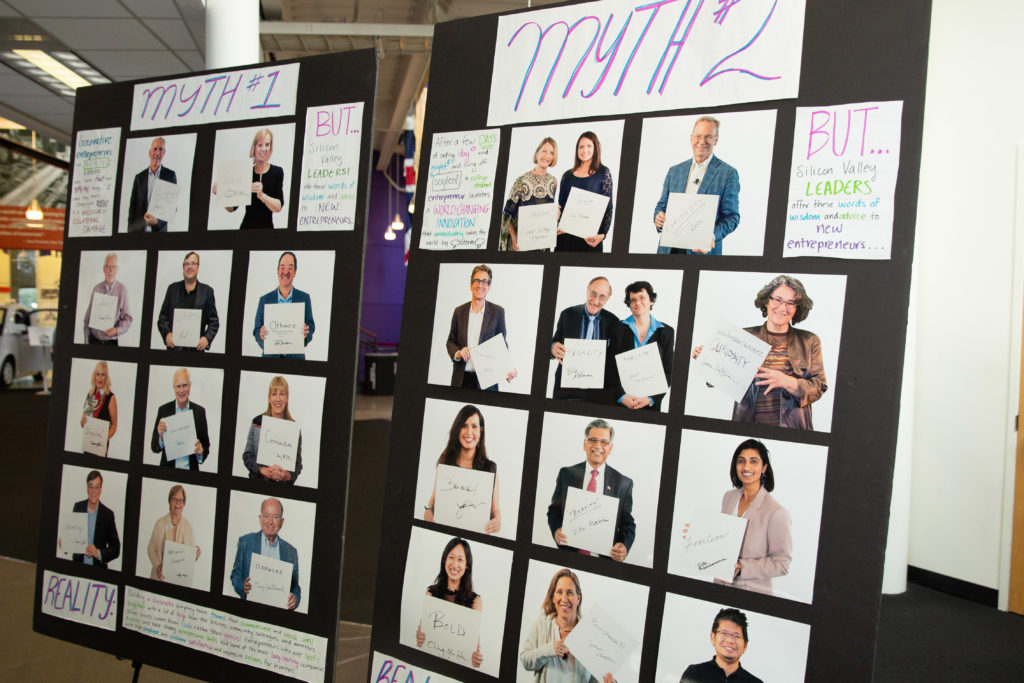
Two “mythbusters” posters created by our interns, displayed at Teen Takeover. These posters convey common exclusionary myths about entrepreneurship—“entrepreneurs are loner-geniuses and extroverts” and “entrepreneurs can only fall under certain demographics”—alongside words of advice from individuals whose success has defied those myths.
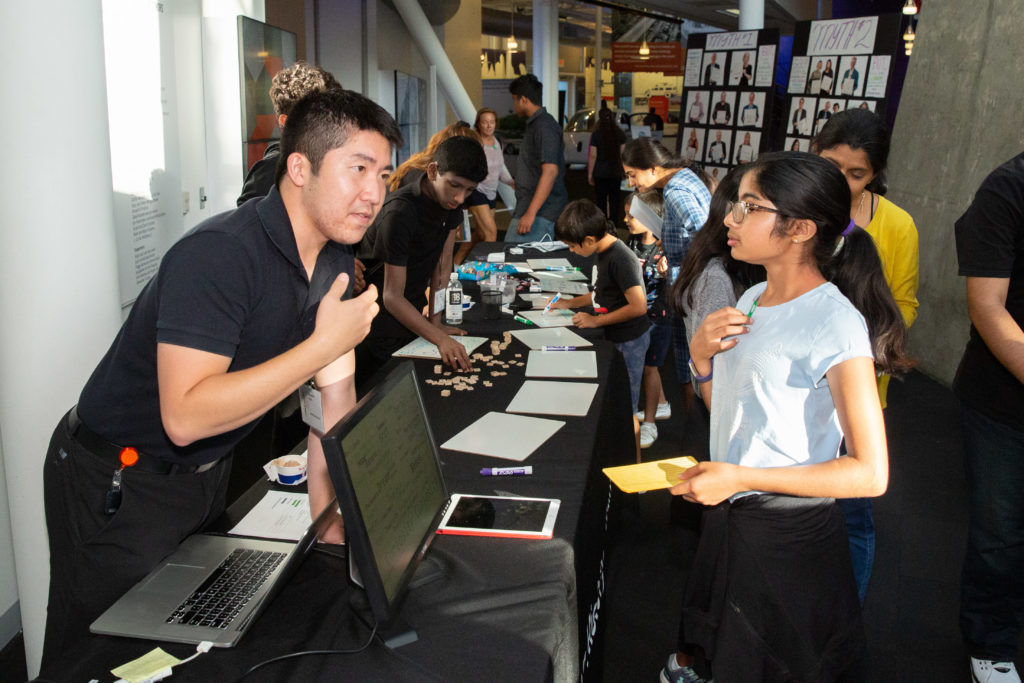
Sungmin explains the One Word “wordle”: participants enter their One Word of advice to entrepreneurs on an iPad. The computer monitor updates in real time to display the words they entered. Words repeated by multiple participants appeared larger on the screen.
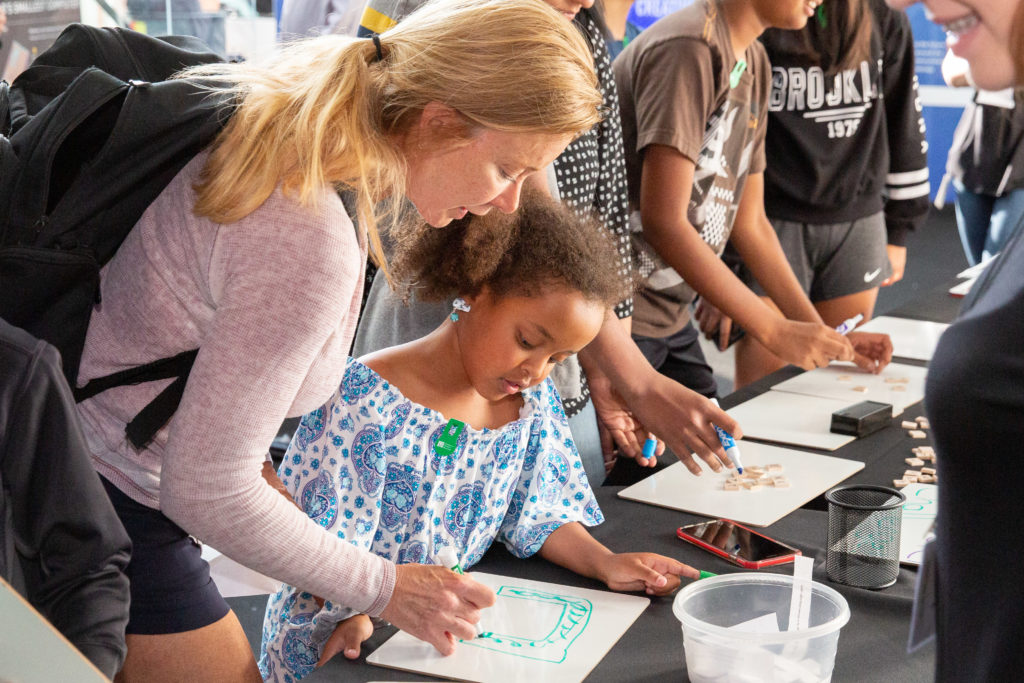
Left: A business pitch challenge in which participants select a fantastical invention and come up with a pitch to convince the “venture capitalists” (our intern team) to invest in the product. Right: A word game in which participants are given scrambled Scrabble tiles and must rearrange them to decipher a word of advice.
After Teen Takeover, our interns focused on researching, becoming experts on company founders and builders in Silicon Valley and beyond. Their findings helped set the stage for a broad array of Exponential offerings, from oral histories to events to exhibits.
Felipe and Sungmin set to work researching future subjects of oral histories to help prepare the interviewer, Exponential Center’s executive director, Marguerite Gong Hancock. But this process would involve much more than writing interview questions.
Felipe chose to prepare background materials on Steve Blank, a serial entrepreneur and educator who has changed the way many think about and operate startups. Felipe drew on a variety of sources, from past interviews to Steve’s own blog. He also had the unique opportunity to study artifacts from Steve’s past, including newspaper articles, magazine ads, and business documents. The artifacts added a tangible element to an otherwise digital research project, helping bring Steve Blank’s history to life for Felipe.
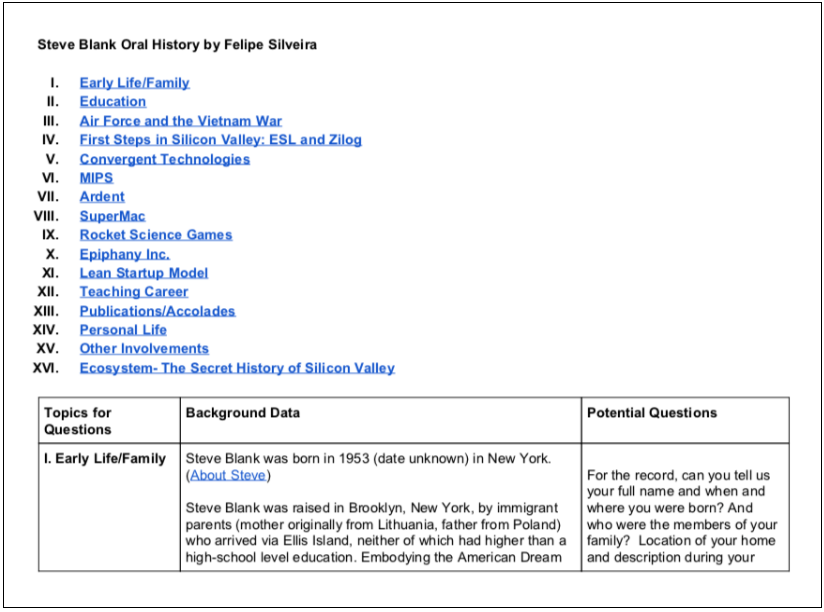
The first page of Felipe’s research guide on Steve Blank, which features 16 subsections. Each covers a significant chapter of Steve’s life, including detailed written accounts and potential interview questions arising from those accounts.
Using these sources, Felipe traced and articulated the arc of Steve’s illustrious career in a 79-page written account. This in turn helped him to develop thought-provoking questions for Steve’s oral history. On the day of the interview, Felipe had the opportunity to meet the individual he had learned so much about. He described the experience as “surreal.”
Meanwhile, Sungmin studied the founders of Intuit: Scott Cook, Tom Proulx, and Eric Dunn. Researching three individuals at the same time was a unique challenge, but it allowed Sungmin to integrate all their perspectives on the founding and building of Intuit.
Sungmin ultimately produced 80 pages worth of research guides and accompanying questions (Nicole assisted in researching Eric Dunn). Though he could not meet the founders before their interviews, he did see them in person at the CHM Live event The Intuit Story, a rare conversation between Scott, Tom and Eric that also drew on Sungmin’s research. Afterward, Sungmin collaborated with Felipe to write a blog article featuring highlights from the panel discussion, now featured on CHM’s new website. Read “Making Change: 36 Years of Innovation at Intuit.”
Like Felipe and Sungmin, Allison and Nicole were lucky enough to see their research subject in person. But theirs was a little harder to shake hands with. Nicole and Allison spent much of their summer investigating Stanford Research Park (SRP), which has been home to foundational Silicon Valley companies like Hewlett-Packard and Fairchild Semiconductor as well as more recent world-changers like Facebook and Tesla.
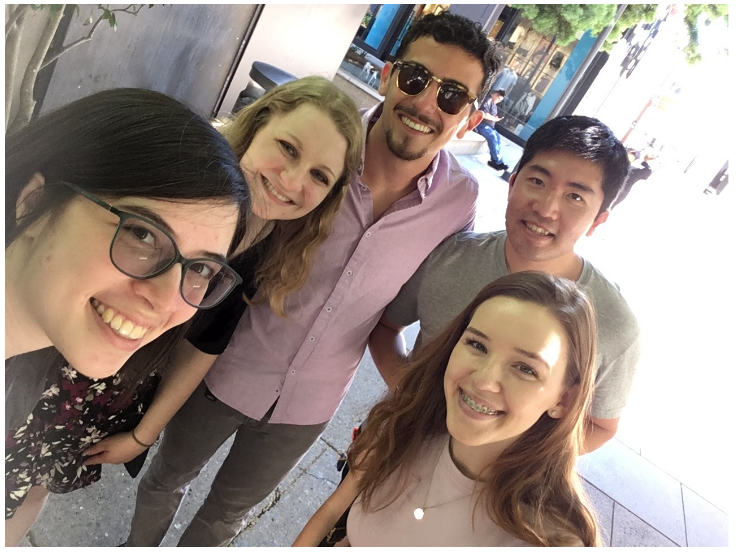
On a blazing July day, Allison and Nicole brought their fellow interns on a field trip to several notable addresses on the campus. Though they had read about its ever-evolving nature, they were surprised to find the landscape of companies fundamentally different than it had been even months before, as represented in the 2019 SRP directory.
Together, Allison and Nicole compiled a rolodex of significant figures in SRP’s history; a “core dig” listing the occupant of each SRP address in 1970, 2014, and 2019, respectively; in-depth research into Varian, SRP’s first tenant; a summary on all their findings; and a bibliography of informational sources on the figures and companies of SRP. Allison and Nicole’s work served as early research and development for a project that will depend on their contributions to take shape.
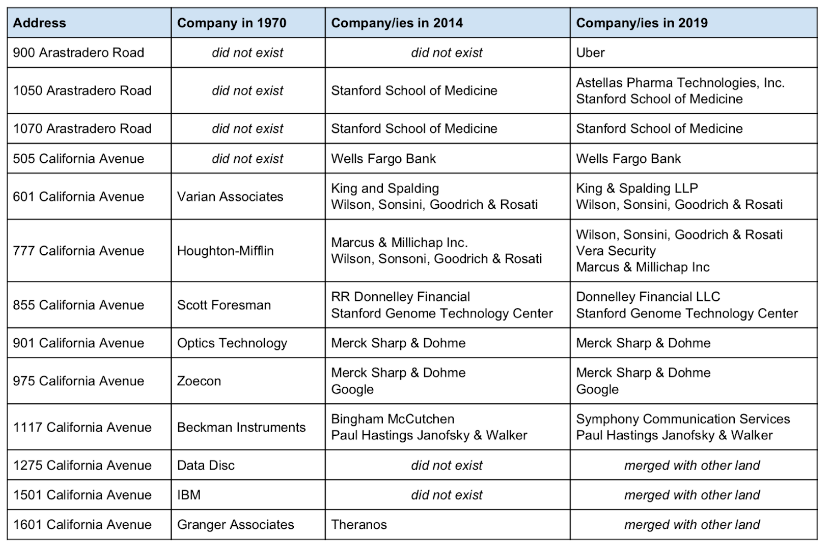
An excerpt from the Core Dig, showing SRP’s growth and change over time.
What is research without (content) development? Drawing on their ever-increasing knowledge of entrepreneurship and innovation in Silicon Valley, interns helped develop a variety of new educational materials and media formats using CHM’s oral history collection.
CHM has roughly 1,000 oral history interviews in its collection. With most interviews consisting of one to three hours of video footage and 20-50 pages of typed transcripts, that’s a lot of material! Our interns created four different digital content prototypes that draw key insights from CHM’s oral histories and aim to make them more accessible through shorter, dynamic formats.
Nicole chose to try kinetic typography, an animation technique that mixes motion and text to express ideas using video animation. As content for her kinetic typography video, Nicole took a short excerpt from Ann Winblad’s oral history interview, a story about Ann’s first entrepreneurial endeavor at age 8: selling Barbie clothes to the neighborhood kids for $1 apiece. The result was a video in which text and images play in time with Ann Winblad’s narration. This type of content is accessible to any age group, but may be especially appealing to a younger audience that is accustomed to consuming much of its content through image-rich videos.
Nicole believes kinetic typography helped to tell Ann’s story in a unique way. But since the process required a several-day time investment, she warns that it could be difficult to repeat on a large scale.
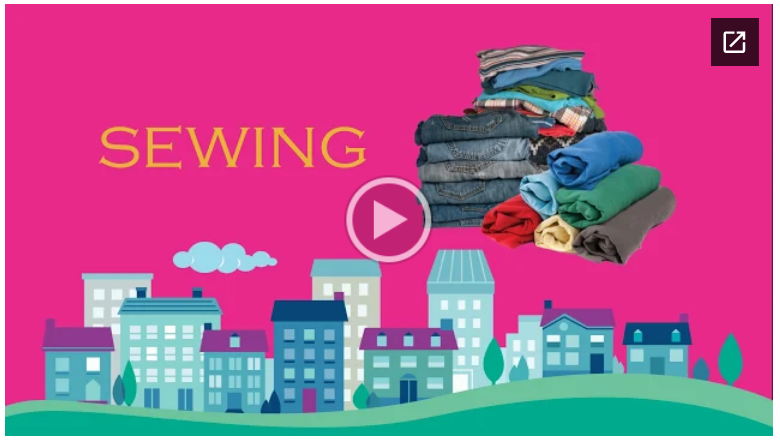
Cover image from Nicole's kinetic typography video. Nicole animated every word of an excerpt from Ann Winblad’s oral history, changing the size or positioning of some words and replacing others with images (for example, an image of a house in place of the word "house") to emphasize key ideas.
Rather than replicating oral history transcripts word-for-word, Sungmin hoped to articulate the themes he had identified while researching the Intuit founders. This drew him to the video essay format. With origins in academia, video essays have become popular for both educational and entertainment purposes.

Screenshots from Sungmin’s prototype video essay on the Intuit story. Sungmin’s video essay synthesizes his background research into a condensed visual telling of the Intuit story and the importance of disruption to the survival of a company over time. He drew on images from CHM’s digital archive.
Sungmin hopes that widely accessible content like his video essay can pique viewers’ interests and lead them to check out the full oral history and even related content, such as event footage.
To complement her counterparts’ video content, Allison worked on a text and image format designed to be consumable almost anytime, anywhere, by anyone: an infographic. Allison’s infographic draws on highlights from YouTube cofounder Steve Chen’s oral history. The information is enhanced by photos, graphics, and a video of YouTube CEO Susan Wojcicki, which is an example of how infographics can serve as an entry point to other CHM content.
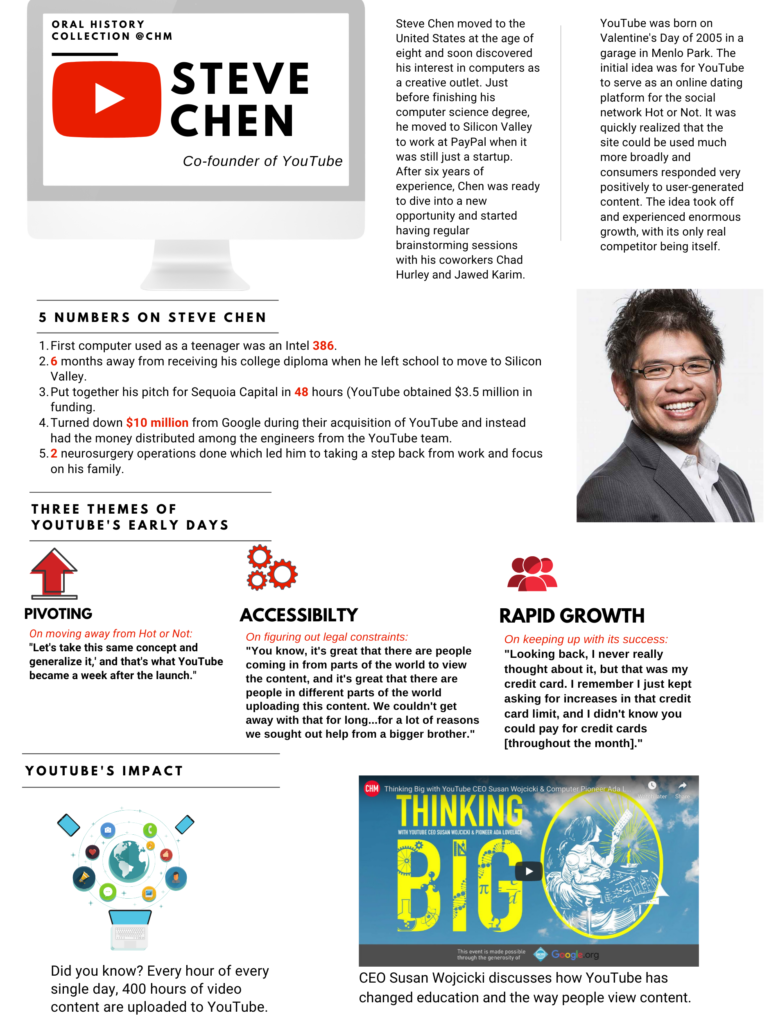
Allison’s infographic on Steve Chen, which presents information in several different formats: short paragraphs on Steve’s early life and the origins of YouTube, a list of Exponential’s signature “five numbers” about Steve, direct quotes from the oral history that point to YouTube’s three guiding themes, and a “Did you know?” piece of trivia.
Allison points out that the template she created for Steve Chen can be used for any other interviewee in our collection, making the project scalable and visually consistent. Allison believes infographics can easily be embedded into the CHM website and are easier to view than videos in the absence of high-speed internet.
Felipe explored a format that could provide an in-depth and visually compelling look at oral history content: a “glideshow,” or photo journal. Viewers “glide” through a slideshow of seamlessly integrated text boxes and photos. Felipe’s photo journal draws on his earlier research of Steve Blank and includes Steve’s early life, his first entrepreneurial endeavors, and his involvement with marketing and the personal computer. This glideshow condenses content from Steve’s 44-page transcript into roughly 6 pages of text, with the added richness of images.

Screenshots from Felipe’s glideshow about Steve Blank, which includes quotes from Steve’s oral history, Felipe’s summaries of key points, and corresponding photos; the section about Steve’s early work at ESL features his ID card from 1980, on which he sports the styles of the time.
These prototypes were presented at an all-staff showcase and opened everyone’s minds at CHM to new content possibilities and ways of thinking.
Our interns have returned to their lives outside CHM with knowledge about the entrepreneur’s journey and ecosystem, experience in finding and synthesizing pertinent information, and the satisfaction of having made a positive contribution to projects and initiatives at CHM. We believe their part in CHM’s transformation will help shape opportunities for us to inspire and be inspired by young people, to enliven and diversify our portfolio of offerings, and to convene and reach new members of our community.
I speak for the Exponential team when I say it was a pleasure to have such talented, hardworking and kind individuals as part of our team this summer. But it has been a unique honor for me, a former Exponential intern, to work so closely with this year’s class and to continue to play a part in the program.
If you’re interested in becoming an Exponential Center intern or have questions about the program, contact Exponential Center Education.